Lay it Out Right
Overview
As app creators, you know that creating a well-structured and visually appealing application layout can often be a challenging task. Balancing aesthetic appeal with functional design can seem daunting, particularly when you're trying to ensure your app is maintainable and user-friendly. This guide is here to help you traverse the landscape of app layout, providing useful pointers to enhance your application's structure, design and interactivity.
Layout 101
This section contains a brief reminder of the two fundamental layout options for arranging elements in your application: Stack and Grid.
Stack
Stack arranges elements linearly, either horizontally or vertically. You're essentially "stacking" your elements, one after the other, in a single row or column. This makes it excellent for aligning items along a single axis and it's perfect when you want your elements to be arranged in a straight line.
from dara.components import Stack
Stack(
Text('This text will appear above'),
Text('this text.')
)
Stack(
Text('This text will appear next to'),
Text('this text.'),
direction='horizontal'
)
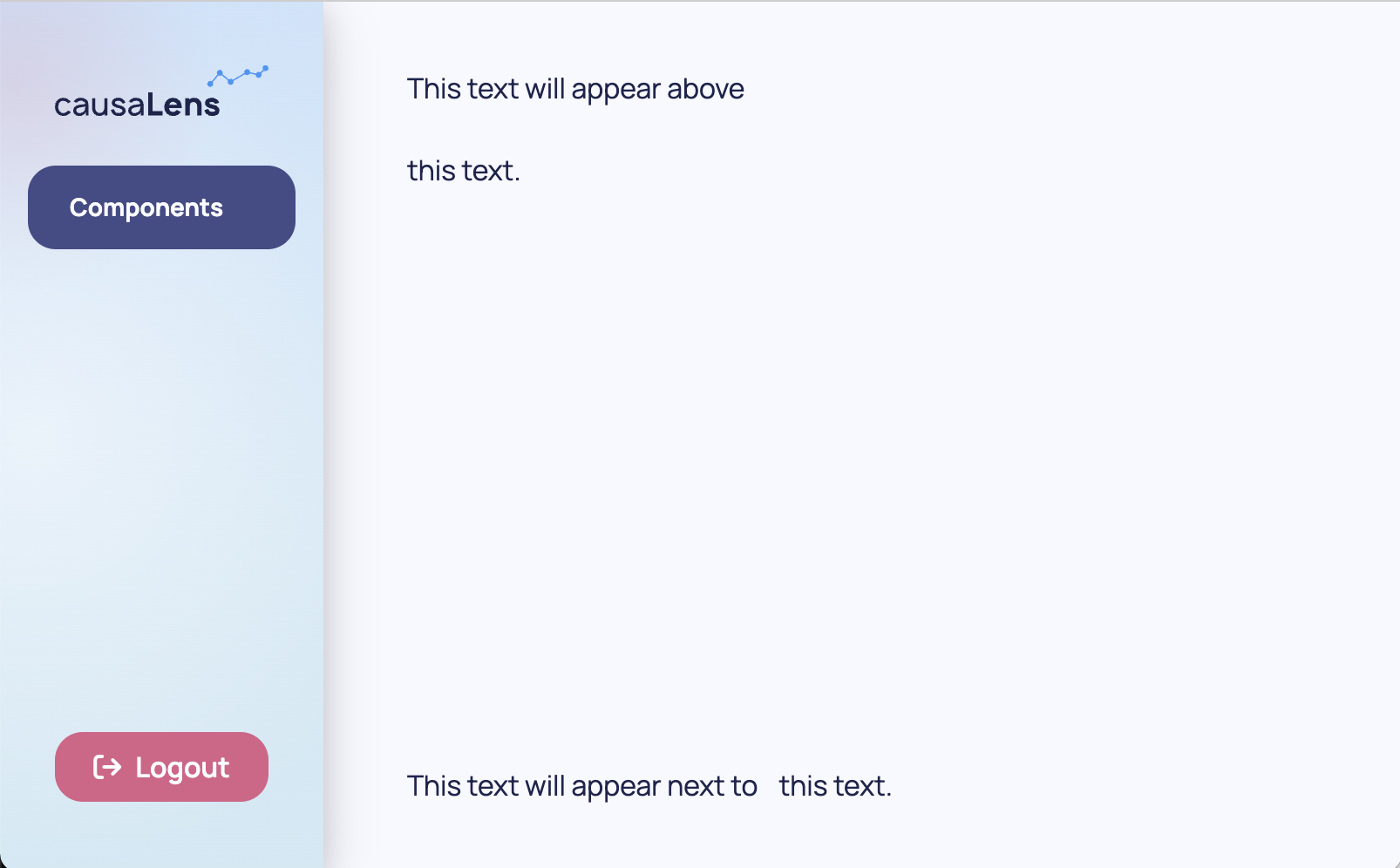
Grid
On the other hand, Grid is more akin to a table. You have rows and columns at your disposal, that allows you to arrange elements both horizontally and vertically. This can be fantastic for both setting an overall higher level layout of your page and for defining more granular two dimensional layouts.
You can think of Grid as a chessboard where each Row is divided into 12 squares. When defining your columns you can decide how many of these squares each Column can occupy, this is called the span of each column.
For the purpose of demonstration, background colors are added to show where one row/column ends and the other begins.
from dara.components import Grid, Text
from dara.core.visual.themes import Light
Grid(
Grid.Row(
Grid.Column(
Text('Row 1 Column 1'),
background=Light.colors.blue2,
justify='center',
span=8
),
Grid.Column(
Text('Row 1 Column 2'),
background=Light.colors.blue3,
justify='center',
span=4
),
padding='10px'
),
Grid.Row(
Grid.Column(
Text('Row 2 Column 1'),
background=Light.colors.blue2,
justify='center',
span=5
),
Grid.Column(
Text('Row 2 Column 2'),
background=Light.colors.blue3,
justify='center',
span=4
),
Grid.Column(
Text('Row 2 Column 3'),
background=Light.colors.blue4,
justify='center',
span=3
),
padding='10px'
),
)
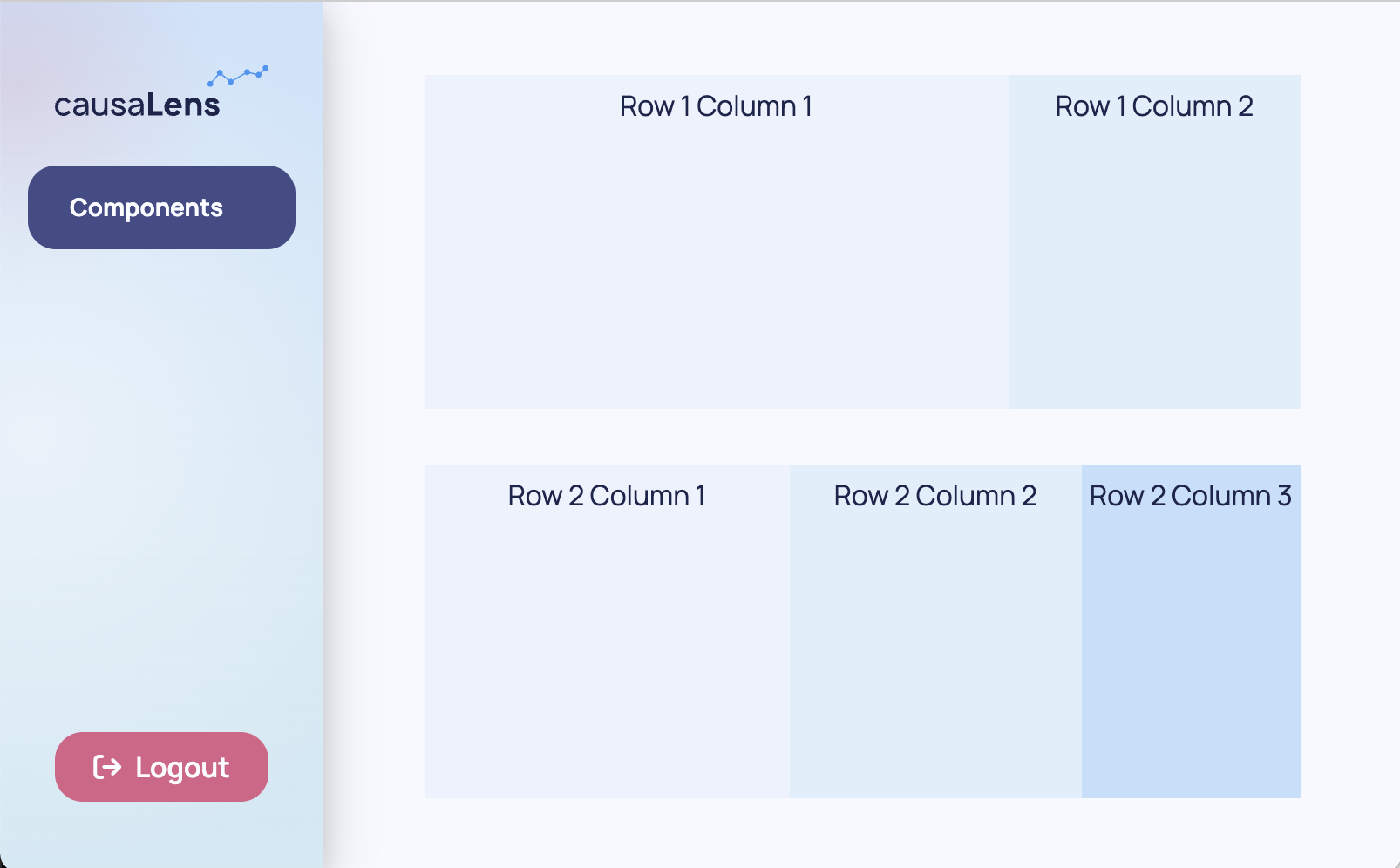
You can specify the space between columns with the column_gap argument of the wrapping Row object. You can specify the space between rows with the row_gap argument of the wrapping Grid object.
In both cases, these layout tools are built on the flex model, which allows for responsive and adaptable layouts. In the following sections, we'll delve more into how to utilize these tools effectively in your application design process.
Stacking it Up: Hug & Scroll
In this section you will learn some more advanced features of Stack, namely two highly useful props hug and scroll.
In the context of a flex container, hug acts somewhat like a function that adjusts the size of a container to fit its content perfectly. In other words, it sets the flex-shrink property to 1 and flex-grow property to 0, making the container just big enough to "hug" or fit its content snugly. This avoids any excess space around the content and can be particularly useful when you want the container to occupy only as much space as its content needs, no more, no less.
from dara.components import Stack, Text
Stack(
# Stack takes as much space as its contents needs
Stack(
Text('I am hug tightly and only occupy as much space as I need'),
background='darkcyan',
hug=True,
),
# this Stack takes the remaining space
Stack(
Text('I stretch to occupy the remaining space available'),
background='tomato',
),
)
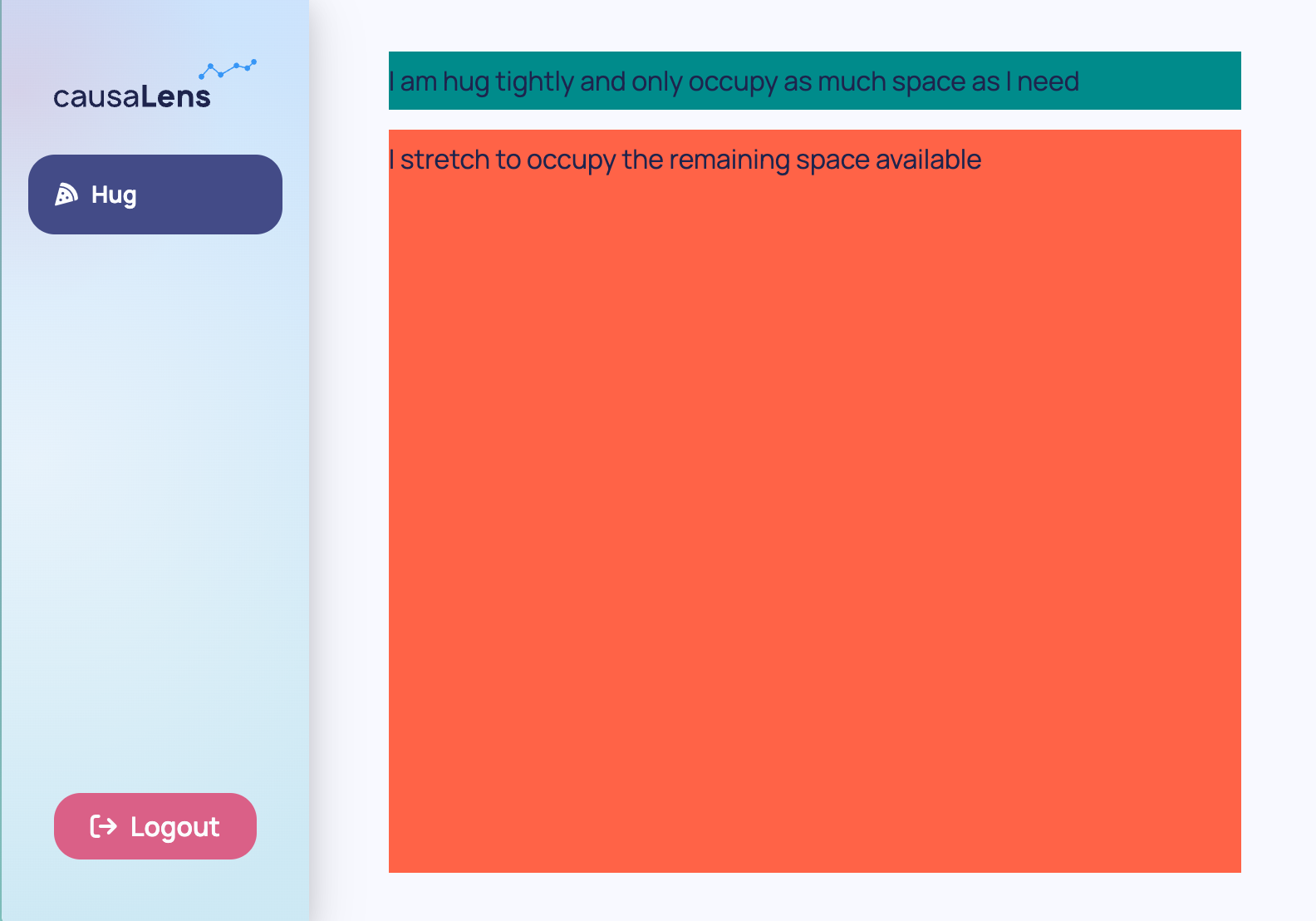
When using hug the Stack will adapt to the size of its contents, so using % for height and width within its descendants will not produce the desired effect. That is unless somewhere down the chain one of the Stacks has an absolute height, that is one set in px, em/rem or vh/vw.
"Scroll", on the other hand, is more like a condition that checks for overflow. This is where an Autosizer comes in. The Autosizer checks if the content exceeds the available space within the container. If the content does overflow, the scroll=True property triggers the addition of scroll bars to that Stack.
In the example below we have a Card with a height of 500px, and a Stack that is free to scroll if its contents overflow the space available. Since the Stack has a Text with height 1000px, that will certainly overflow the 500px space available in the card, therefore it will gain vertical scroll bars.
By default if scroll is not set then the Stack will overflow the space of the Card. In this example the coral background spills out of the Card.
from dara.components import Stack, Text
Card(
Stack(
# this inner has content which is 1000px in height
Text('I overflow', height='1000px'),
background='coral',
scroll=True,
),
# outer Stack has 500px room
height='500px',
)

One last topic to note is how these two params interact. As mentioned above scroll when set to True uses an autosizer, what that means is that it starts with zero height and "scans" the space available, it then uses that value to define the space the Stack can end up taking. On the other hand hug starts with the size of the content. So when both are used together hug starts with zero height and is not able to grow. For these cases, where you want a Stack to both hug and scroll you should set the overflow property to auto instead.
from dara.components import Stack
Stack(
...# some content
hug=True,
overflow='auto',
)
When dealing with CausalGraphViewer, Table, Plotly and scrollable Stacks:
These components are special in that they essentially "scan" the space available on the page before they render. This is good because it allows them to adapt to their surroundings but it comes with drawbacks.
If you place them in a container that hashugset toTrue, hug tries to make the space only as big as it needs to. So there is a conflict of interest as there is no space leftover for them to take. In that case they will take their default min_height. So if you are using these components within a hugcontainer you may need to overwritemin_height` of the component should you want them to take more space on the screen.
Hugging in other layout components
The hug property is also supported on a few other layout components:
Grid,Grid.RowandGrid.ColumnCardTabbedCard
As an example, you may want to set Grid.Row to not grow to fill the space available in the Grid but instead only occupy as much as its contents need:
from dara.components import Grid
Grid(
Grid.Row(
...# some content
hug=True
),
...,
)
Scrolling beyond Stacks
Similarly scroll is currently not implemented in Grid.Column, Card and Tab. To achieve scrollable content in those scenarios it is recommended to add a Stack within it and set scroll=True.
Mastering the Flex
Both Stack and Grid components are built on top of flexbox layout. Having a mastery of its basic properties will allow for greater control over the layout of your apps. In this section you will learn about the key properties which you may want to set.
Grow
grow (aka flex-grow) is the "growth factor". When you have extra space in your container and you want your elements to use up that space, flex-grow decides how much of this extra space each element should consume. If all elements have the same flex-grow value, they will share the extra space equally. If the values are different, they'll consume space proportional to their flex-grow value. If set to False or 0 it means that the container will not grow beyond the initial basis value.
If set, this value can be set to True which equals a grow factor of 1, or False equaling to 0. It can also take any other value that is accepted by flex-grow.
Shrink
shrink (aka flex-shrink), on the other hand, deals with the scenario where there's not enough space in the container to fit all the elements. Flex-shrink dictates how much each element should "shrink" to fit into the container. If all elements have the same flex-shrink value, they will shrink equally when the container is too small. If the values are different, they'll shrink in proportion to their flex-shrink value. If set to False or 0 it means that the container will not shrink beyond the initial basis value.
If set, this value can be set to True which equals a grow factor of 1, or False equaling to 0. It can also take any other value that is accepted by flex-shrink.
Basis
basis (aka flex-basis) is a way of setting the size the component starts with. In a flex container, it determines the initial main size of a flex item before any available space is distributed according to the flex-grow and flex-shrink factors. Think of it as setting an initial size or "base" for an element.
These three properties form one called flex and act in the direction of the container. That is for a vertical Stack it will grow/shrink and define initial size vertically resulting in some final height, for horizontal Stack horizontally defining the final width the component takes.
Gap
Layout components such as Stack, Card, Tab, Grid.Column all have a default gap of 0.75rem. This means that as you add components as children there will be a 0.75rem space between them automatically. This is useful to avoid content being too crowded and having to manually add a Spacer between each component.
from dara.components import Stack
Stack(
Heading(...),
# hidden gap of 0.75rem
Card(...),
# hidden gap of 0.75rem
Card(...),
)
This can be easily changed by setting the gap property to a different value:
from dara.components import Stack
Stack(
Heading(...),
# hidden gap of 2rem
Card(...),
# hidden gap of 2rem
Card(...),
gap='2rem',
)
However suppose that now you would like certain heights applied to these components, Heading should take 10% of the space available, and each Card should take 30% and 60% respectively:
from dara.components import Stack, Heading, Card
Stack(
Heading(..., height='10%'),
# hidden gap of 2rem
Card(..., height='30%'),
# hidden gap of 2rem
Card(..., height='60%'),
gap='2rem',
)
The heights add to 100%, but this Stack would overflow! This is because of gap, counting the true height you have 10% + 2rem + 30% + 2rem + 60% = 100% + 4rem.
To avoid this there are three different methods you can follow:
- Leave one of your
Cards without a height set, since they haveshrinkset to 1 by default (if height not set) it will shrink to fit the remaining space available.
from dara.components import Stack, Heading, Card
Stack(
Heading(..., height='10%'),
# hidden gap of 2rem
Card(..., height='30%'),
# hidden gap of 2rem
# takes remaining space available
Card(...),
gap='2rem',
)
- Add
shrink=Trueto each of the child components or the ones you would like to be able to "absorb" some of the space thatgaptakes
from dara.components import Stack, Heading, Card
Stack(
# Heading takes exactly 10%
Heading(..., height='10%'),
# hidden gap of 2rem
# This Card in practice will take 30% - 2rem
Card(..., height='30%', shrink=True),
# hidden gap of 2rem
# This Card in practice will take 60% - 2rem
Card(..., height='60%', shrink=True),
gap='2rem',
)
- Account for the
gapsize when considering the heights manually with the help ofcalc:
from dara.components import Stack, Heading, Card
Stack(
# calc calculates x% of the space available minus the two gaps divided between the 3 components evenly
Heading(..., height='calc(10% - (2rem / 3))'),
# hidden gap of 2rem
Card(..., height='calc(30% - (2rem / 3))'),
# hidden gap of 2rem
Card(..., height='calc(60% - (2rem / 3))'),
gap='2rem',
)
Justify and Align
Justify and align are about how elements are positioned in the container.
Justify (aka justify-content) determines the alignment of items along the main axis of the container. For example in a vertical Stack along the y-axis or height axis. You could center them, space them evenly, or align them to one side.
Align (aka align-items) works similarly, but it deals with the cross axis — the axis perpendicular to the main axis. In the vertical Stack example it aligns your components in the x-axis or width axis. It determines how items are laid out vertically in a row setup or horizontally in a column setup. It can align all items to start (top or left), end (bottom or right), center, or even stretch to fill the container.
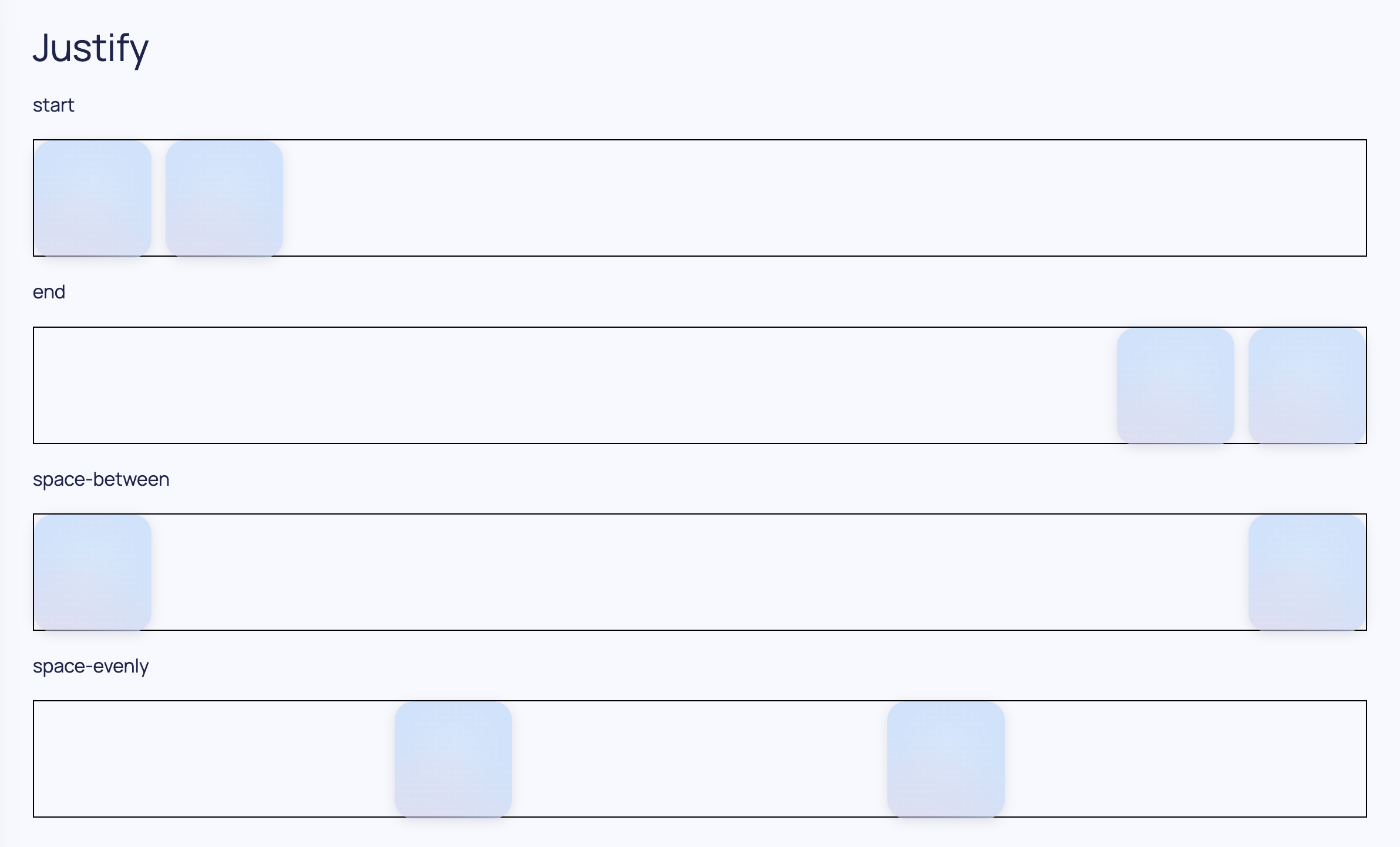
from dara.components import Stack, Heading, Card, Text
Stack(
Heading('Justify'),
Text('start'),
Stack(
Card(height=100, width=100, accent=True),
Card(height=100, width=100, accent=True),
justify='start',
direction='horizontal',
border='1px solid black',
height=100
),
Text('end'),
Stack(
Card(height=100, width=100, accent=True),
Card(height=100, width=100, accent=True),
justify='end',
direction='horizontal',
border='1px solid black',
height=100
),
Text('space-between'),
Stack(
Card(height=100, width=100, accent=True),
Card(height=100, width=100, accent=True),
justify='space-between',
direction='horizontal',
border='1px solid black',
height=100
),
Text('space-evenly'),
Stack(
Card(height=100, width=100, accent=True),
Card(height=100, width=100, accent=True),
justify='space-evenly',
direction='horizontal',
border='1px solid black',
height=100
),
)
Testing Your Layout
When you're diving into layouts, it's crucial to remember that your app will be viewed on a range of screen sizes - from compact laptop screens to expansive secondary monitors. To make sure your app looks great across the board, you can start by simply zooming in and out in your browser. This will give you an initial feel for how your components adjust to different zoom levels.
Want a more in-depth look? The 'dev tools' is your go-to. One way of accessing it in most browsers is by right-click on your page and select 'inspect' from the dropdown. This will open a sidebar which has many tools to test the state of your app. One of the features it offers is the ability to simulate different screen resolutions. You can find this option in both Firefox and Chrome, represented by an icon displaying various devices. By selecting this, you can input specific screen resolutions to check out how responsive your app truly is.
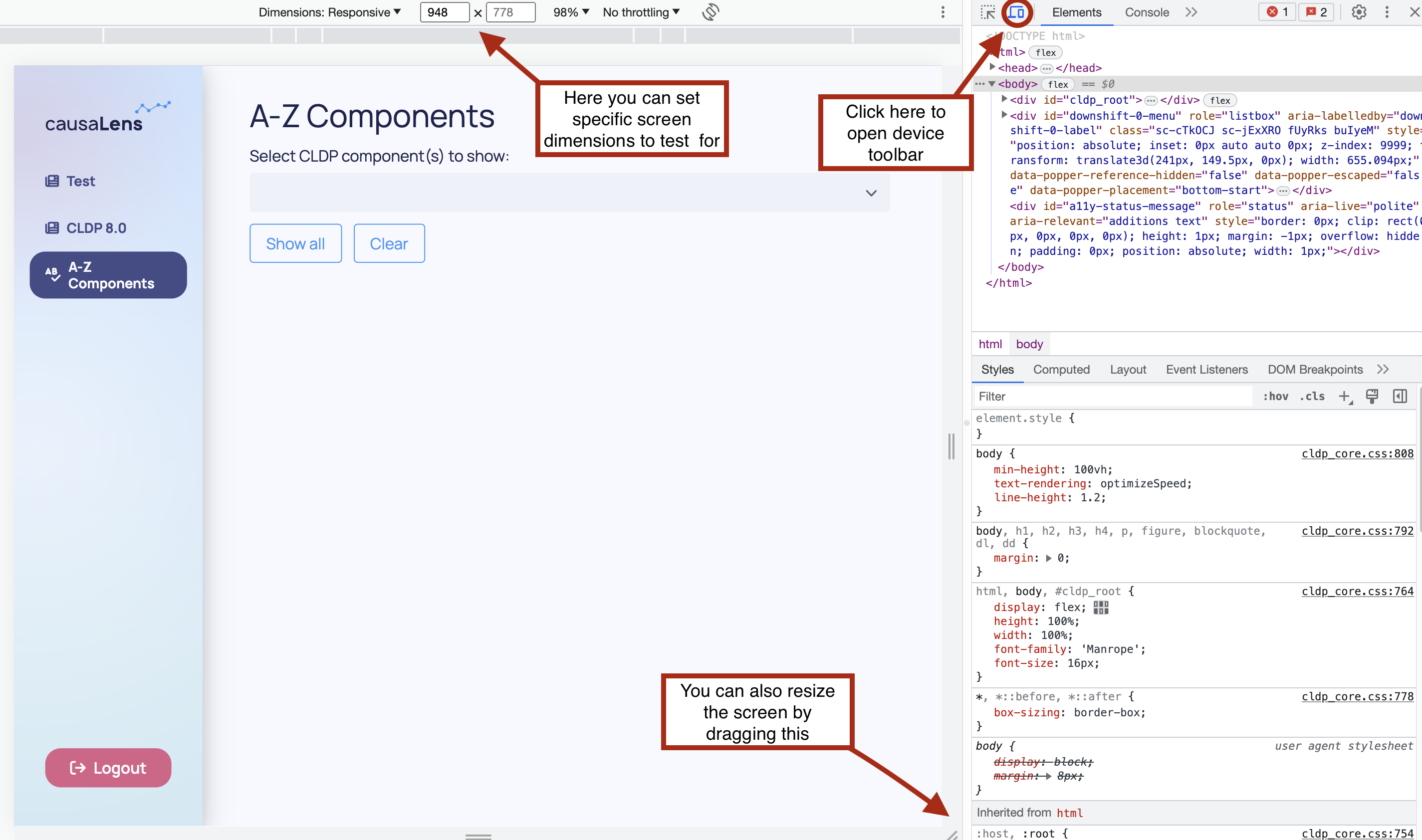
While you're doing all this resizing, keep an eye out for any content that might overflow or areas that could have too much vacant space. Building a responsive app right off the bat requires careful consideration of the units you use for setting heights and widths. Absolute units, like "px", stay fixed no matter what the screen size is. Which could be very useful for certain items that should maintain a size, for example a heading on a page, however some other components such as plots or cards might benefit from changing size to fit nicely within the screen, for these relative units, like "%", could be more appropriate. You should choose which to use on a case by case basis.
Finally, remember to test for sections of your app that could house variable content. Imagine you've got a component that adds a row to a list every time a user clicks on a point in a graph. You'd want to see how it behaves when the list is empty, when it has a few elements, and when it's overflowing with entries. By doing this, you're ensuring your app is not just responsive, but also resilient in handling varying content.